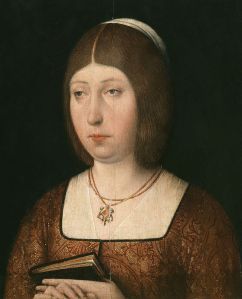
Isabella (b. 1451) was the only daughter of Juan II of Castile and Isabella of Portugal. She had two brothers – an older half-brother, Enrique IV, and a younger brother Alfonzo of Castile.
When Enrique came to the throne in 1454, Isabella, her mother, and her younger brother all moved to reside in Arévalo until Enrique’s second wife, Juana of Portugal, gave birth to a baby girl. Enrique then insisted his siblings should return to court.
When it came to arranging her marriage, Isabella had the right to veto any spousal choices that she did not approve of. Her choice was Fernando II, King of Aragon and Navarre. The agreed power sharing dynamic between the two regnant monarchs meant that each would govern their respective kingdoms in their own right.
The couple would go on to have five children who would reach adulthood, including their youngest daughter Catherine of Aragon, mother to Mary I of England.
Isabella’s reign as Queen of Castile began in December 1474 and she became Queen of Aragon when Fernando ascended to his throne in 1479.
Her reign was most notable for aspects such as the strengthening of governmental institutions in Castile, her support of Christopher Columbus’ expedition to the Americas, and the establishment of a Spanish Empire. Isabel and Fernando were also behind the expulsion of Muslims and Jews from their kingdoms to solidify them as Catholic nations.
Isabella died in 1504 and was buried in the Royal Chapel of Granada, designed by her grandson, Holy Roman Emperor Carlos V. She was buried alongside her husband, her daughter Juana and Juana’s husband Philip I, and Isabella’s grandson Miguel.
Recommended Reading
Giles Tremlett, Isabella of Castile: Europe’s First Great Queen (London: Bloomsbury, 2017)
M. Lunefeld, “Isabella I of Castile and the Company of Women in Power,” Historical Reflections / Réflexions Historiques 4 (1977): 59-79
Theresa Earenfight, “Two Bodies, One Spirit: Isabella and Ferdinand’s Construction of Monarchical Partnership,” in Queen Isabel I of Castile: Power, Patronage, Persona, ed. Barbara F. Weissberger, 3-18 (Woodbridge: Boydell & Brewer, 2008).
